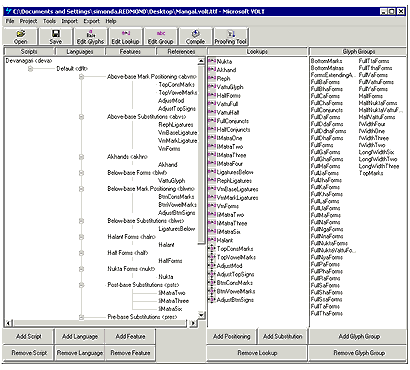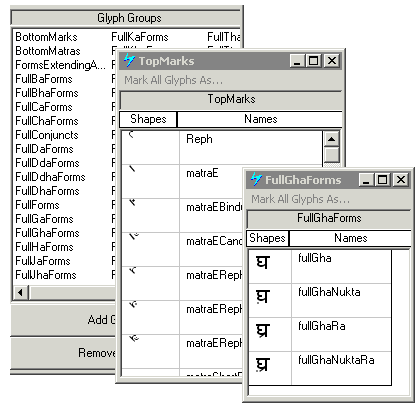Using VOLT: The project window

The Main project window provides a bird's eye view of the OpenType Layout table structure of the font you are working on. OTL table generation is a well-defined, structured activity that makes use of a 'building block' concept. The individual panes contain details at different levels.
The rightmost pane shows units called 'glyph groups'. The smallest unit of information for generating glyph groups is the glyph. These units help string together glyphs. Glyph groups are the building blocks for lookup generation. The lookup pane lists lookups used by features. These lookups string together glyph groups and glyphs to enable glyph substitutions and positioning.
The leftmost pane includes information from the lookup and glyph group panes, as well as information about scripts, languages and features. It allows the font developer to see the overall structure of the OTL tables constructed for the font.
Viewing glyphs
Selecting the 'Edit Glyphs' button launches the glyph grid, where you can view glyphs, their names, CMAP entries and assigned types. For ligatures, you can also set the number of components they have (which affects mark-to-ligature positioning lookups and caret placement inside ligatures).

Creating the feature tree
From the main project window, you can create the Script / Language System / Feature / Lookup tree. Input each item in the form 'name <tag>' (with the tag in angular brackets). You can input the tag only or name only and VOLT will deduce the other part for all registered tags.

The list of registered tags is stored in the VOLT application directory in a file called tags.txt. More updates will become available as we register more tags. In future versions of VOLT, the mechanism will be changed to getting the localized names through NLS+. The order that features are listed is for ease of locating applied features, and does not imply nor affect lookup processing order.
Scripts, language systems and features are always sorted alphabetically. The order of these does not affect the processing order in the font.
Language systems with tag <dflt> are marked by VOLT as default language systems. Features with tag <dflt> are marked by VOLT as required features. Please note a difference with raw OTL format here, where any feature or language system can be designated as required or default.
Adding lookups
To add lookups to features, you must create them separately in the 'lookup list' and then drag-and-drop them into corresponding features.
Lookups are not arranged alphabetically like the feature list. Lookups appear as they are executed, each called only once. Therefore, it is important that the order is determined in advance by the font developer.
To change the order of lookups, drag-and-drop them in the lookup list. This will change their appearance order in the feature tree as well.
Adding glyph groups
You can add glyph groups in the main project window. Having glyph groups does not have any effect on font functionality, but using predefined groups in lookups may really speed things up. To reference a group in a substitution or positioning lookup, write the group's name in angular brackets, e.g. <Capitals>.

Groups are always displayed in alphabetical order.
Names
Anything that has a tag (scripts, language systems and features) may have a name with any kind of characters in it. These items are referenced by their tags. All names are case sensitive. Glyph names can contain only letters and digits. With VOLT version 1.1, we also allow '.' and '_' characters in glyph names.